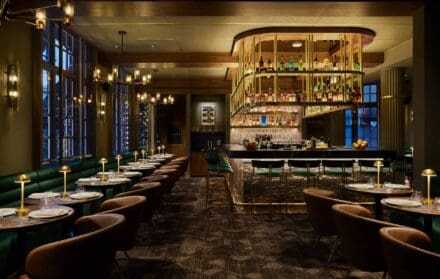
Takara Shuzo: The hunt for the world’s rarest whisky
Japanese spiritmaker, Takara Shuzo, produced one of the country's most exquisite whiskies, yet it never officially created a single malt. Or did it?
If most detective stories are, in the end, a whodunit, Stephen Bremner’s is more of a whereisit. Bremner is the managing director of Scotch whisky maker Tomatin Distillery Co, and works in the small town of Tomatin, 15 miles down the A9 from Inverness. Yet, thanks to some serious digging, a lot of questioning and countless hours of rifling through old documents on the other side of the world, he’s now also in possession of a bottling from Takara Shuzo. Whisky which is arguably the oldest and rarest of Japanese single malts and is now, take a deep breath, selling for £25,000 a bottle.
Why, Bremner had long wondered, was so little known about the history of malt whisky production by Takara Shuzo – Tomatin’s parent company – and, in particular, about the whisky produced by its pioneering distillery in Shirakawa, located in the Fukushima Prefecture some 200km north of Tokyo? The Shirakawa distillery had, after all, already been making whisky for almost 20 years, between 1951 and 1969, before switching to the production of other spirits. Its buildings were finally demolished in 2003 and the land later gifted to local people following the devastating 2011 tsunami. The lack of interest had always puzzled Bremner. So, when rumours began circulating that a lost batch of Takara Shuzo still existed, somewhere, he began to investigate.
“It was one of those situations where I’d been working for Takara Shuzo for almost 20 years and over time came to hear about how they’d once had this malt whisky distillery in Shirakawa. So I’d ask, ‘Is there any stock left?’ And I’d always get a sketchy answer,” Bremner explains.
“In part that was because Takara Shuzo is a really big company, and in part, because the guys I’d ask likely would [for cultural reasons] never put the question further up the food chain. So I’d just get a ‘no, we don’t think so’ all the time. But then one day I asked another Japanese colleague and he told me that there were rumours of a lost parcel of stock. He’d spoken to the right people – but then he got moved to a US subsidiary. So I tracked him down, had a number of conversations with him, and so the hunt began.”

Firstly, Bremner tracked down a couple of employees – now retired – who had worked at the distillery in the 1980s. “They knew about this parcel, knew some things but they didn’t know much,” says Bremner. The demolishing of the Shirakawa distillery meant that many of the historical records had been lost, but some, including notes regarding production in the 1950s, had survived.
“We just started to put together all these small pieces of information – the type of barley that would have been used then, the type of casks, and slowly this information gave us the clarity we needed to convince us that this parcel really did exist. We got the impression that some people at the company, though not many, had heard about this parcel too but just didn’t think about it too much, especially as this is a company that’s long been about another product entirely. And, besides, the Takara Shuzo’s warehouses are pretty enormous.”
“Even if this whisky had come from Scotland the only reaction would have been ‘Wow!’”
Stephen Bremner
Indeed they are. Picture the closing scene of Raiders of the Lost Ark, in which the Ark of the Covenant is hidden away in an anonymous crate among millions of crates in a vast warehouse. Now, picture a similarly anonymous stainless steel container, ignored and untouched for decades, in the corner of a similarly vast warehouse in the Miyazaki Prefecture, at the other end of Japan. And yet, there it was, finally uncovered in 2019, full of this very special brew. Small wonder that some in the whisky trade have, laughs Bremner, tried to paint him as some kind of Indiana Jones. “Unfortunately, I’m not that cool.”
The alcohol archaeology didn’t stop there. With documentation awry, how could Bremner know he’d found what he thought he’d found? Samples were sent to Scotland for independent analysis by two specialist companies – they confirmed that the liquid had been matured for decades, and, most importantly, that it was a single malt.
So, what’s the big deal? The excitement to whisky nerds lies in the fact that Shirakawa produced whisky only for blending, notably for its Takara Shuzo’s flagship King brand – it never, officially anyway, produced a single malt bottling. This is the last remaining parcel of just 1,500 bottles of a secret single malt – the only single malt from the now-demolished Shirakawa distillery. In fact, distilled in 1958, the bottling is the earliest known single vintage (that is, from one single year) from any Japanese distillery.

“From the whisky buff’s point of view that makes it extremely interesting,” says Bremner. For those not so into the whisky side of things, its rarity makes it interesting from an investment perspective. The past 10 years have seen Japanese whisky, and single malts especially, become very collectible – indeed, for many collectors, it’s right up there. And they like the Japanese single malts that are lesser known.”
Commercial whisky production in Japan began in 1924, upon the opening of the country’s first distillery, and, while the quality wasn’t world-class, the spirit found growing popularity during the US occupation post-World War Two. The domestic market kept growing until the late 1970s, when the drink industry’s radical shift from brown to white spirits – vodka and gin, mostly – persuaded many manufacturers to shift production to shochu, a traditional Japanese white spirit distilled using sweet potato, barley or corn.
At the time, shochu was regarded as a low-class, rough-neck drink. Takara Shuzo would reinvent it as an upscale spirit, called Jun, in part through a marketing campaign involving David Bowie, Sheena Easton and John Travolta, and in part by being the first company to mature shochu, just like whisky, in casks. Whisky somewhat fell off the radar. It wasn’t until around the turn of the millennium that an interest in Japanese whisky – now from niche, small-batch producers – began to pick up, revived in part through two examples (Suntory’s Hibiki 21-year-old and Nikka’s Yoichi 10-year-old) grabbing first and second prize at Whisky Magazine’s Best of the Best contest in 2001.

“I think there was a snobbishness about Japanese whisky that held back its appreciation, but competition wins encouraged more people to try it and discover that it’s produced to a very high standard,” says Bremner. “They reflect that cultural Japanese attention to detail. And in the last few years, interest in Japanese whisky has gone through the roof. That this mysterious release has been several years in coming together – and the fact that nothing about the process has been straightforward – only adds to the intrigue. It’s been difficult getting here, that’s for sure.”
Even now, not everything about the single malt is fully understood. Bremner can’t, for example, be precise as to how many years the whisky spent in cask. There can be no certainty around production methods either, though analysis suggests Japanese malted barley and Mizunara oak casks, both of which would be hard to replicate today.
Of course, age and rarity do not automatically make for good-tasting whisky – especially one that’s been stored in stainless steel tanks of the kind used for shochu. After tracking the stuff down, Bremner was, understandably, nervous upon trying it for the first time.
“We could have found it and discovered that it was just not very good, and we couldn’t have released it. So I have to say that when I first went to taste it I was slightly apprehensive. And I think the owners of the distillery were nervous about letting me taste it, too, because even in their eyes Scotch is still at the top of the whisky pyramid.”
When Bremner did eventually taste the whisky, he was blown away. “I would quite happily put it up against our top single malts. They [the distillery] had no idea what they had. They had no idea how significant it was. It was just unbelievable. Even if this whisky had come from Scotland the only reaction would have been ‘Wow!’”
Bremner’s batch predates the first ever known Japanese single malt by 17 years, and the boom in interest in Japanese single malts by some three decades. Unsurprisingly, the 1,500 bottles that have resulted have piqued the interest of collectors around the world.
What, then, are the chances of uncovering another lost batch? “We’ve looked but I can assure you that there’s no more Shirakawa after this.”
Shirakawa 1958, £25,000, visit tomatindistillery.com
Read more: Woven by Adam Smith: Coworth Park’s secret weapon finally gets his name above the door






